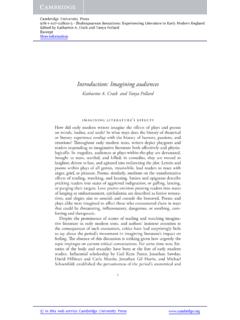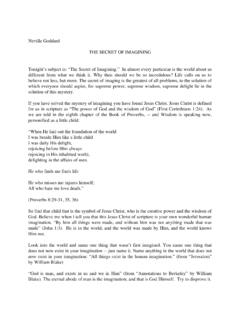Transcription of Scheherazade’s secret: the power of stories and the desire ...
1 Australian Journal of Adult Learning Volume 51, Special Edition, December 2011 scheherazade s secret: the power of stories and the desire to learnPeter WillisUniversity of South AustraliaIn this paper I use a story to introduce the idea of stories in adult educational practice. Telling stories seems to be as old as human culture. MacIntyre referred to humans as story-telling animals (1981: 201). The secret is the ways in which this storytelling capacity can be used in a holistic humanistic pedagogy.
2 Education, the process of assisting others to learn, can be pursued by seeking to pass on information (propositional pedagogy); by showing how to do something (skilling pedagogy) and by inviting learners to become different (transformative pedagogy). Many actual educational exchanges involve learners in more than one kind of learning where the educational event has elements of information and skills transfer, often combined at least tacitly with an invitation to become different. In this paper I suggest that the telling of stories that capture the imagination and move the heart is a powerful pedagogy in inviting scheherazade s secret 111learning not so much to do with gaining new information, although this can often happen, nor transferring skills, which again can also occur, but with a deeper transformative form of learning, which is really more about learners changing their identity, their way of seeing and acting upon the world.
3 IntroductionThe title of this paper goes back to the mythical Arabian Nights when a legendary king used to take a new wife and after one night would order her killed and would take another. scheherazade , one of the available young women, offered herself to the king and held him in thrall with her stories so that he delayed her execution, and slowly modified his approach to life as he reflected on the mystery, excitement and grandeur of her tales and allowed them further purchase on his soul. He ceased his murderous practice and eventually married her.
4 scheherazade s secret was to evoke a response from the king s hitherto undeveloped capacity for wisdom and compassion through her use of imaginal and archetypal stories , which were based not so much in historical fact as in the human capacity to be struck and transformed by accessible truth and wisdom. Other evocative stories are based more in historical reality but, in a way not dissimilar to scheherazade s performance, real incidents are then represented and interpreted in a story that makes their implications and messages visible and challenging.
5 It is the use of stories in fostering learning that is of interest here. stories and learning have multiple dimensions, which I will discuss briefly after giving a real example of the pedagogic impact of a story drawn from real life. This is the story of John Howard Griffin, the white man who dyed his skin black and lived for more than a month as a black itinerant worker in the southern states of the USA. Griffin s restrained and vivid story, told in his book Black like me, created a strong learning ferment among black and white American readers.
6 112 Peter WillisHis realistic story, which caught his readers up in his portrayed experience, convinced them to accept the inhumane reality of their divided American society where whites excluded, humiliated and oppressed their black neighbours, which either they had denied or of which they were actually ignorant. Let us begin with the white activist John Howard Griffin and his story of racial adventure in the deep south of the like meIn 1956 John Howard Griffin, a white Christian social justice activist and journalist, carried out a social experiment in the southern states of the USA.
7 He dyed his skin black and spent more than a month as a black man travelling in the south of the USA in search of work. He told the story of his black experience in his book Black like me, published in 1961. From the moment his experiment started and he had become black , he could not believe his exclusion from familiar citizen activities. He tells of walking for miles in search of work, being refused a seat in cafes, refused service at bus stops, and excluded from public toilets unless they were specially designated for blacks.
8 He was ignored and sometimes abused in public places by white people. This upright, well-regarded citizen started to keep a low profile to avoid being the butt of white violence, knowing that the law would not protect him. He noted the strength of his distaste, fear and distress. He also pointed out, more analytically, that the racist behaviour of individual whites was condoned, if not encouraged, by mainstream American and Christian culture. He saw that he and many other so-called good white Americans were unwittingly compliant.
9 Griffin s book became a bestseller. He was feted and threatened at the same time. His black/white story became a catalyst for the white awareness movement, leading to current culture where black voices have replaced their white interpreters and amplifiers. To read this book now is to hear an aesthetic and cultivated person confronted scheherazade s secret 113with an inhuman social regime pursued in the southern region of the USA under his nose. He began to realise that the form of egalitarian and respectful Christian whiteness practised by him and his family was often not the one in common use.
10 He felt wretched; images of black degradation and neglect stayed with him; his analytical mind was spinning as he tried to understand how a nominally Christian country could condone or even promote such rejection and subjugation. He concluded that much of this neglect was not known and certainly the experience of such disdainful exclusion was not understood. He decided to tell his story to white America of what, even to the small extent of his experience, being black is like: what he saw and felt, how his mind spun in confusion and his heart felt in disarray.



















